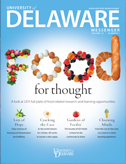

Linda Wright, EG82, ANR86M
Chocolate researcher extraordinaire
ALUMNI & FRIENDS | What makes chocolate so delicious?
When studying its chemistry—the flavor, the texture blend, the matrix of its particles—it appears the cocoa butter fat melts almost magically at human body temperature.
That’s Linda Wright’s explanation for why it tastes so good, and as director of chocolate research for Hershey, she certainly would know.
In a role as delicious as it sounds, Wright, EG82, ANR86M, uses fresh ingredients and new technologies to develop the kinds of sweet products consumers want. Perks include serving on taste testing panels two to three times a day. Challenges typically center on the variation among ingredients manufactured by the Earth, where raw products like milk, cocoa beans, almonds and peanuts can vary constantly.
“With chocolate, you have a very complex system of how to make it, of how many places in the world we rely on,” she says. “When you start to understand the supply chain, you see the complexity.”
The vanilla may have an “off flavor,” for instance. Or the cocoa might taste too bitter or sour, depending on a region’s soil.
As a result, Wright and the 20-person research team she manages must test new products all the time, with the goal of developing more Hershey products that make it to the aisles of the grocery store. A simple formula might take about six months, though the projects in Wright’s department tend to be more patentable, multiyear initiatives that balance both flavor and cost. And sometimes her focus is less on new products and more on improved processes.
For instance, when Hershey purchased the Canadian-based Brookside Chocolate, known for its dark chocolate-coated exotic fruit-flavored centers, the interest in the product line “practically exploded,” so much so that the Canada plant could not keep up with production.
That’s where Wright’s team entered the equation. Rather than replicating the line, she spearheaded a project that cut down operations by 50 percent and reduced processing time from four days to one. The yearlong improvements included identifying new cooking procedures and technologies that could optimize production, such as removing water earlier in the stages to cure the fruit faster. Consumer tests showed that she could match the product taste and quality, and her engineering acumen helped her develop a system that increased throughput (the quantity produced per day) by three times on the new system.
More recently, Wright has been deeply involved in Hershey’s “Simple Ingredients” initiative. In February 2015, after the company announced its commitment to use simpler, more familiar ingredients in products across its broad product portfolio, Wright’s team immediately undertook this challenge. By the holiday season, they had reformulated the iconic Milk Chocolate Kisses and Bars, which now contain no artificial flavors but have the same delicious taste—with a simpler label. And they continued that work in 2016, adding a half-dozen more products to the list.
Wright applied to Hershey 27 years ago, after reading a newspaper job description for a process engineer in the famed chocolate plant. At the time, some 150 people applied for the position, but Wright was hired for her powerhouse combination of chemical engineering and research in food science (as a master’s student, she worked with professors Bob Fisher and Dietrich Knorr on the “supercritical extraction” of Vitamin E, and later worked on optimizing taste and consistency for quick-cooking rice).
“Hershey held UD’s programs in high regard,” she remembers. “And it certainly helped my résumé stand out.”
Today, she has worked on the creation of scores of products, from the popular Reese’s Pieces to one of Wright’s short-lived favorites, the ChipAway, chocolate-covered cookie balls that she thinks “may have been ahead of its time.”
The traditional package of two Reese’s Peanut Butter Cups remains the company’s bestseller, and part of Wright’s job is to understand shifting tastes and consumer demands (which, she describes as heading toward more “multidimensional tastes and textures.”)
“It’s really been quite a fascinating career,” Wright admits. “You never get done learning new things in the world of science—or the world of chocolate. And it would have never happened without UD.”



